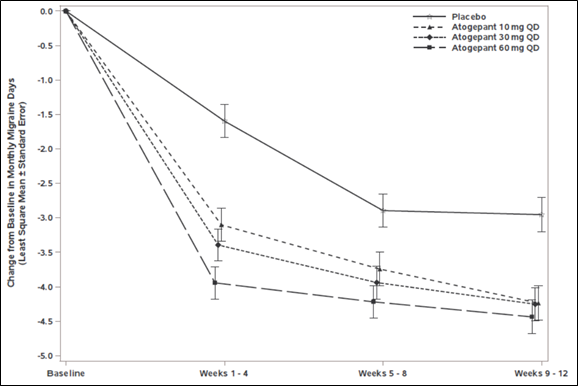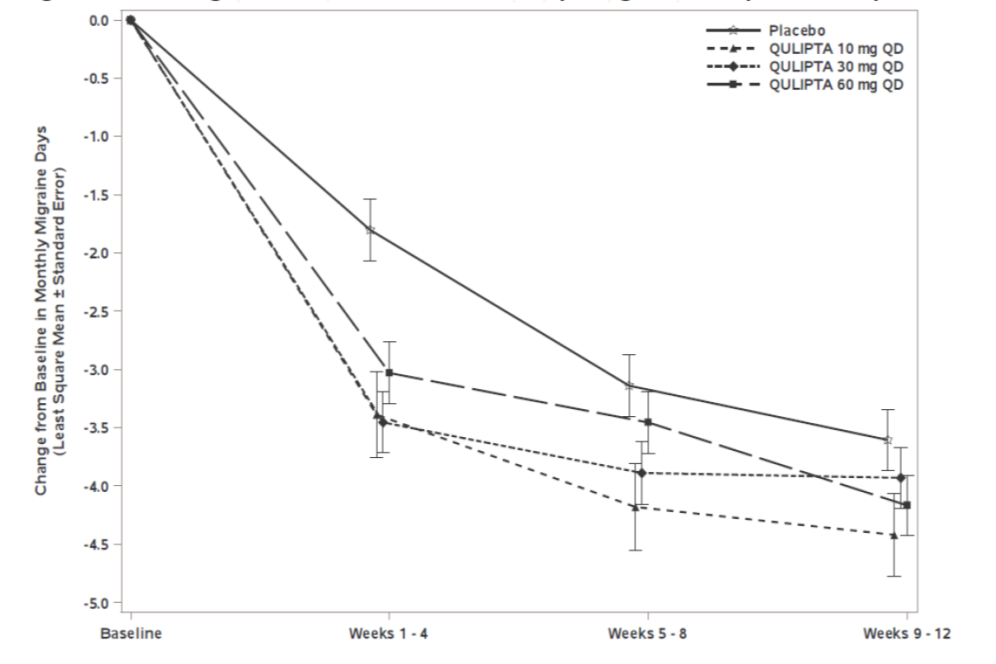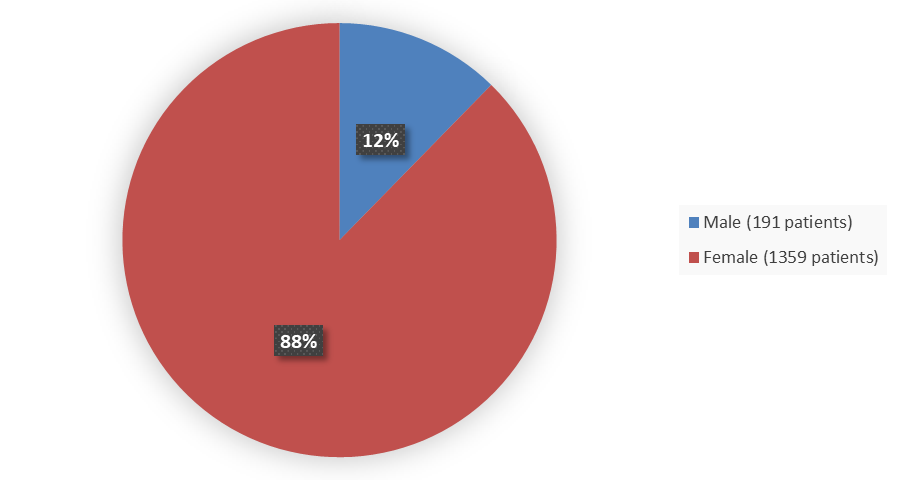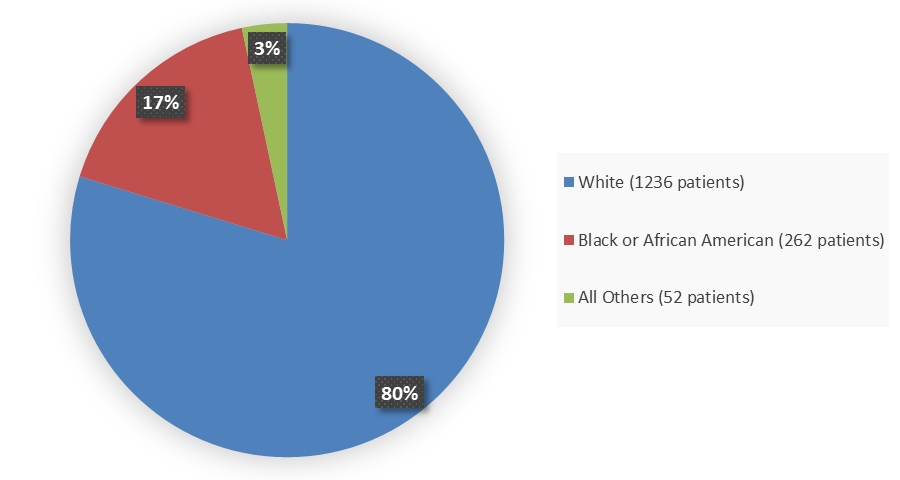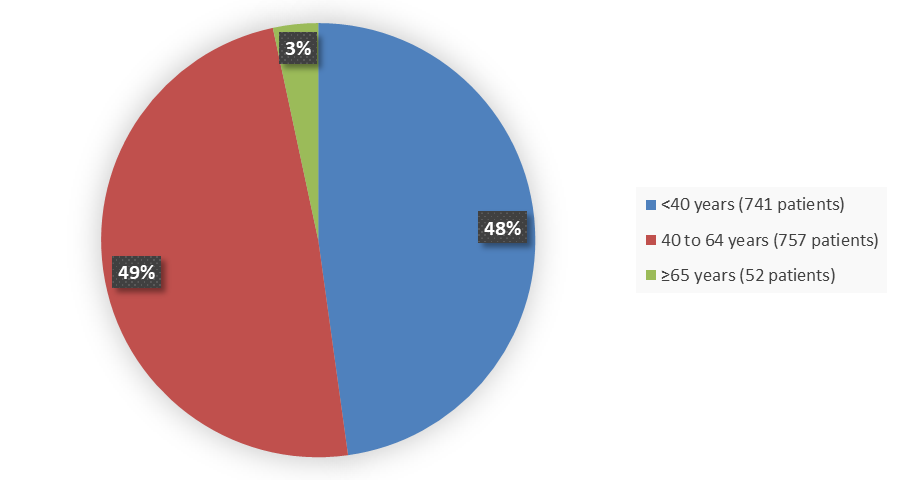Drug Trials Snapshots: QULIPTA
HOW TO USE THIS SNAPSHOT
The information provided in Snapshots highlights who participated in the key clinical trials that supported the original FDA approval of this drug, and whether there were differences among sex, race, age, and ethnic groups. The “MORE INFO” bar shows more detailed, technical content for each section. The Snapshot is intended as one tool for consumers to use when discussing the risks and benefits of the drugs.
LIMITATIONS OF THIS SNAPSHOT
Do not rely on Snapshots to make decisions regarding medical care. Always speak to your healthcare provider about the benefits and risks of a drug.
Some of the information in this Snapshot is for presentation purposes and does not represent the approved conditions of use of this drug. Refer to the QULIPTA Prescribing Information for all of the approved conditions of use of this drug (e.g., indication(s), population(s), dosing regimen(s), safety information).
Snapshots are limited to the information available at the time of the original approval of the drug and do not provide information on who participated in clinical trials that supported later approvals for additional uses of the drug (if applicable).
QULIPTA (atogepant)
(kew-LIP-tah)
AbbVie, Inc.
Approval date: September 28, 2021
DRUG TRIALS SNAPSHOT SUMMARY:
What is the drug for?
QULIPTA is a drug used daily for the preventive treatment of episodic migraine (with headaches occurring up to 14 days per month) in adults.
A migraine is a type of headache that can be associated with nausea, vomiting, and/or sensitivity to light or sound.
How is this drug used?
QULIPTA is a tablet taken by mouth daily with or without food.
Who participated in the clinical trials?
The FDA approved QULIPTA based on evidence from 2 clinical trials of 1,562 patients with episodic migraine. The trials were conducted at over 100 sites in the United States. The safety of QULIPTA was evaluated in 1,958 patients with migraine who received at least one dose of QULIPTA; therefore, the number of patients representing efficacy findings may differ from the number of patients representing safety findings due to different pools of study participants analyzed for efficacy and safety.
What are the benefits of this drug?
Patients treated with QULIPTA experienced fewer days of migraine headaches per month, in comparison to patients who received placebo treatment.
What are the benefits of this drug (results of trials used to assess efficacy)?
Figure 1 and Figure 2 below summarize the efficacy results for the evaluated subjects for Trials 1 and 2. The primary outcome was the change in monthly migraine days (MMD).
Figure 1. Change From Baseline in Monthly Migraine Days in Trial 1
Source: Adapted from FDA Review
Abbreviations: QD, once daily
Figure 2. Change From Baseline in Monthly Migraine Days in Trial 2
Source: Adapted from FDA Review
Abbreviations: QD, once daily
Were there any differences in how well the drug worked in clinical trials among sex, race and age?
- Sex: QULIPTA worked similarly in males and females.
- Race: The number of patients of races other than White was small; therefore, differences in how QULIPTA worked among races could not be determined.
- Age: QULIPTA worked similarly among patients younger and older than 40 years of age. The number of patients older than 65 years of age was limited; therefore, differences in how QULIPTA worked among patients younger and older than 65 years of age could not be determined.
Were there any differences in how well the drug worked in clinical trials among sex, race, and age groups?
Table 1 and Table 2 below summarize efficacy results by sex, race, and age in Trials 1 and 2.
Table 1. Subgroup Efficacy Analyses – Trial 1
| Subgroup | Arm | Total Patients | Change From Baseline | Effect Difference (95% CI) | ||||||
|---|---|---|---|---|---|---|---|---|---|---|
| Age (years) | <40 | Placebo | 111 | -2.47 | ||||||
| 10 mg QD | 98 | -3.59 | -1.12 (-1.98, -0.26) | |||||||
| 30 mg QD | 96 | -3.91 | -1.44 (-2.30, -0.58) | |||||||
| 60 mg QD | 98 | -3.94 | -1.47 (-2.33, -0.61) | |||||||
| ≥40 to <65 | Placebo | 93 | -2.41 | |||||||
| 10 mg QD | 109 | -3.74 | -1.33 (-2.12, -0.54) | |||||||
| 30 mg QD | 119 | -3.73 | -1.31 (-2.08, -0.54) | |||||||
| 60 mg QD | 116 | -4.57 | -2.16 (-2.93, -1.38) | |||||||
| >65 | Placebo | 10 | -3.20 | |||||||
| 10 mg QD | 7 | -4.27 | -1.08 (-4.47, 2.32) | |||||||
| 30 mg QD | 8 | -4.96 | -1.77 (-5.02, 1.49) | |||||||
| 60 mg QD | 8 | -1.77 | 1.43 (-1.87, 4.73) | |||||||
| Race | White | Placebo | 188 | -2.47 | ||||||
| 10 mg QD | 176 | -3.71 | -1.24 (-1.83, -0.66) | |||||||
| 30 mg QD | 181 | -4.08 | -1.61 (-2.19, -1.03) | |||||||
| 60 mg QD | 184 | -4.42 | -1.95 (-2.53, -1.38) | |||||||
| Black | Placebo | 22 | -2.08 | |||||||
| 10 mg QD | 32 | -3.77 | -1.69 (-3.76, 0.39) | |||||||
| 30 mg QD | 37 | -2.88 | -0.80 (-2.83, 1.23) | |||||||
| 60 mg QD | 27 | -2.85 | -0.77 (-2.92, 1.37) | |||||||
| All other races | Placebo | 4 | -3.44 | |||||||
| 10 mg QD | 6 | -4.98 | -1.54 (-5.91, 2.83) | |||||||
| 30 mg QD | 5 | -6.34 | -2.90 (-7.72, 1.92) | |||||||
| 60 mg QD | 10 | -3.07 | 0.36 (-3.70, 4.43) | |||||||
| Sex | Female | Placebo | 190 | -2.54 | ||||||
| 10 mg QD | 193 | -3.69 | -1.15 (-1.75, -0.54) | |||||||
| 30 mg QD | 199 | -3.90 | -1.36 (-1.96, -0.76) | |||||||
| 60 mg QD | 191 | -4.15 | -1.62 (-2.23, -1.01) | |||||||
| Male | Placebo | 24 | -2.06 | |||||||
| 10 mg QD | 21 | -3.69 | -1.63 (-3.40, 0.14) | |||||||
| 30 mg QD | 24 | -3.57 | -1.52 (-3.18, 0.15) | |||||||
| 60 mg QD | 31 | -4.46 | -2.40 (-3.98, -0.82) | |||||||
Source: Adapted from FDA Review
Abbreviations: CI, confidence interval; QD, once daily
Table 2. Subgroup Efficacy Analyses – Trial 2
| Subgroup | Arm | Total Patients | Change From Baseline | Effect Difference (95% CI) | |
|---|---|---|---|---|---|
| Age (years) | <40 | Placebo | 82 | -2.95 | |
| 10 mg QD | 52 | -3.98 | -1.03 (-2.09, 0.02) | ||
| 30 mg QD | 90 | -3.66 | -0.71 (-1.62, 0.20) | ||
| 60 mg QD | 82 | -3.78 | -0.83 (-1.76, 0.09) | ||
| ≥40 to <65 | Placebo | 91 | -2.87 | ||
| 10 mg QD | 35 | -4.15 | -1.27 (-2.51, -0.03) | ||
| 30 mg QD | 80 | -3.59 | -0.71 (-1.67, 0.25) | ||
| 60 mg QD | 92 | -3.32 | -0.44 (-1.37, 0.48) | ||
| >65 | Placebo | 4 | -1.64 | ||
| 10 mg QD | 4 | -1.51 | 0.13 (-2.82, 3.08) | ||
| 30 mg QD | 9 | -6.21 | -4.57 (-7.08, -2.06) | ||
| 60 mg QD | 2 | -3.89 | -2.25 (-5.90, 1.40) | ||
| Race | White | Placebo | 131 | -2.79 | |
| 10 mg QD | 68 | -3.87 | -1.08 (-2.02, -0.15) | ||
| 30 mg QD | 142 | -3.67 | -0.89 (-1.64, -0.13) | ||
| 60 mg QD | 129 | -3.40 | -0.62 (-1.39, 0.15) | ||
| Black | Placebo | 42 | -3.04 | ||
| 10 mg QD | 19 | -4.31 | -1.27 (-2.78, 0.24) | ||
| 30 mg QD | 28 | -4.35 | -1.30 (-2.66, 0.05) | ||
| 60 mg QD | 38 | -4.07 | -1.03 (-2.26, 0.20) | ||
| All other races | Placebo | 4 | -2.85 | ||
| 10 mg QD | 4 | -3.60 | -0.75 (-4.95, 3.45) | ||
| 30 mg QD | 9 | -3.64 | -0.80 (-4.57, 2.97) | ||
| 60 mg QD | 9 | -3.14 | -0.29 (-4.05, 3.48) | ||
| Sex | Female | Placebo | 150 | -2.98 | |
| 10 mg QD | 80 | 3.92 | -0.94 (-1.76, -0.11) | ||
| 30 mg QD | 162 | -3.69 | -0.71 (-1.39, -0.03) | ||
| 60 mg QD | 147 | -3.50 | -0.51 (-1.21, 0.18) | ||
| Male | Placebo | 27 | -2.22 | ||
| 10 mg QD | 11 | -4.25 | -2.03 (-4.41, 0.35) | ||
| 30 mg QD | 17 | -4.46 | -2.24 (-4.28, -0.21) | ||
| 60 mg QD | 29 | -3.66 | -1.44 (-3.21, 0.32) | ||
Source: Adapted from FDA Review
Abbreviations: CI, confidence interval; QD, once daily
What are the possible side effects?
The most common side effects of QULIPTA were nausea, constipation, fatigue/somnolence, and decreased appetite.
What are the possible side effects (results of trials used to assess safety)?
Table 3 below summarizes the most common adverse reactions in adult patients with episodic migraine headaches in Trials 1 and 2 (safety population, pooled).
Table 3. Adverse Reactions Occurring in ≥2% and at a Frequency Greater Than Placebo in Trials 1 and 2
| Adverse Reaction | QULIPTA 10 mg N=314 % |
QULIPTA 30 mg N=411 % |
QULIPTA 60 mg N=417 % |
Placebo N=409 % |
|---|---|---|---|---|
| Nausea | 5 | 6 | 9 | 3 |
| Constipation | 6 | 6 | 6 | 1 |
| Fatigue or somnolence | 4 | 4 | 6 | 3 |
| Decreased appetite | 2 | 1 | 2 | <1 |
Source: QULIPTA Prescribing Information
Were there any differences in side effects among sex, race and age?
- Sex: The occurrence of the side effects of constipation and nausea was increased in female patients compared to male patients.
- Race: The number of patients of patients of races other than White was small; therefore, differences in the occurrence of side effects could not be determined.
- Age: The occurrence of side effects was similar in patients below and above 65 years of age, except the occurrence of constipation which increased with age.
Were there any differences in side effects of the clinical trials among sex, race, and age groups?
The tables below summarize the occurrence of the most common adverse reactions (nausea, constipation, and fatigue/somnolence), by subgroup.
Table 4. Adverse Reactions by Sex
| Preferred Term | Female | Male | ||
|---|---|---|---|---|
| QULIPTA1 n/N (%) |
Placebo n/N (%) |
QULIPTA n/N (%) |
Placebo n/N (%) |
|
| Nausea | 70/1007 (7.0) | 13/352 (3.7) | 5/135 (3.7) | 0/56 (0) |
| Constipation | 66/1007 (6.6) | 5/352 (1.4) | 4/135 (3.0) | 0/56 (0) |
| Fatigue or somnolence | 47/1007 (4.7) | 11/352 (3.1) | 7/135 (5.2) | 3/56 (5.4) |
Source: Adapted from FDA Review
1 QULIPTA pooled doses (10 mg, 30 mg, and 60 mg daily doses)
Table 5. Adverse Reactions by Race
| Preferred Term | White | Black or African American | Other2 | |||
|---|---|---|---|---|---|---|
| QULIPTA1 n/N (%) |
Placebo n/N (%) |
QULIPTA n/N (%) |
Placebo n/N (%) |
QULIPTA n/N (%) |
Placebo n/N (%) |
|
| Nausea | 63/905 (7.0) | 10/331 (3.0) | 9/193 (4.7) | 2/69 (2.9) | 3/44 (6.8) | 1/8 (12.5) |
| Constipation | 60/905 (6.6) | 3/331 (0.9) | 9/193 (4.7) | 1/69 (1.4) | 1/44 (2.3) | 1/8 (12.5) |
| Fatigue or somnolence | 44/905 (4.9) | 13/331 (3.9) | 8/193 (4.1) | 1/69 (1.4) | 2/44 (4.5) | 0/8 (0) |
Source: Adapted from FDA Review
1 QULIPTA pooled doses (10 mg, 30 mg, and 60 mg daily doses)
2 Other includes Asian and American Indian or Alaska Natives, as numbers were overall small in these subgroups.
Table 6. Adverse Reactions by Age
| Preferred Term | <40 Years | 40 to 64 Years | ≥65 Years | |||
|---|---|---|---|---|---|---|
| QULIPTA1 n/N (%) |
Placebo n/N (%) |
QULIPTA n/N (%) |
Placebo n/N (%) |
QULIPTA n/N (%) |
Placebo n/N (%) |
|
| Nausea | 37/537 (6.9) | 7/204 (3.4) | 37/567 (6.5) | 6/190 (3.2) | 1/38 (2.6) | 0/14 (0) |
| Constipation | 24/537 (4.5) | 3/204 (1.5) | 42/567 (7.4) | 2/190 (1.1) | 4/38 (10.5) | 0/14 (0) |
| Fatigue or somnolence | 26/537 (4.8) | 8/204 (3.9) | 25/567 (4.4) | 6/190 (3.2) | 3/38 (7.9) | 0/14 (0) |
Source: Adapted from FDA Review
1 QULIPTA pooled doses (10 mg, 30 mg, and 60 mg daily doses)
DEMOGRAPHICS SNAPSHOT
Figure 3 summarizes the percentage of male and female patients that were enrolled in the clinical trials used to evaluate the efficacy and safety of QULIPTA.
Figure 3. Baseline Demographics by Sex
Source: Adapted from FDA Review
Figure 4 summarizes the percentage of patients by race enrolled in the clinical trials.
Figure 4. Baseline Demographics by Race
Source: Adapted from FDA Review
Figure 5 summarizes the percentage of patients by age in the clinical trials.
Figure 5. Baseline Demographics by Age
Source: Adapted from FDA Review
How were the trials designed?
The benefits and side effects of QULIPTA were evaluated in two clinical trials of patients with a history of migraine headaches occurring on 4 to 14 days per month. The two trials to show the benefits were designed similarly. Trials 1 and 2 assigned patients to one of several doses of QULIPTA or placebo daily for 3 months. Neither the patients nor the health care providers knew which treatment was being given until after the trial was completed. The benefit of QULIPTA was assessed based on the change from baseline in the number of migraine days per month to the last month of the 3-month treatment period, comparing patients in the QULIPTA and placebo groups.
How were the trials designed?
Trials 1 and 2 were randomized, placebo-controlled, double-blind, 3-month trials evaluating QULIPTA for the preventive treatment of episodic migraine in adult patients with up to 14 migraine headache days per month. Patients were randomized to QULIPTA at doses of 10 mg, 30 mg, or 60 mg, or placebo. Patients could use acute headache treatments. The primary efficacy endpoint was the change from baseline in the monthly average migraine days during the 3-month period.
GLOSSARY
CLINICAL TRIAL: Voluntary research studies conducted in people and designed to answer specific questions about the safety or effectiveness of drugs, vaccines, other therapies, or new ways of using existing treatments.
COMPARATOR: A previously available treatment or placebo used in clinical trials that is compared to the actual drug being tested.
EFFICACY: How well the drug achieves the desired response when it is taken as described in a controlled clinical setting, such as during a clinical trial.
PLACEBO: An inactive substance or “sugar pill” that looks the same as, and is given the same way as, an active drug or treatment being tested. The effects of the active drug or treatment are compared to the effects of the placebo.
SUBGROUP: A subset of the population studied in a clinical trial. Demographic subsets include sex, race, and age groups.

